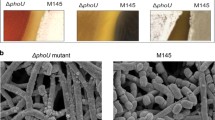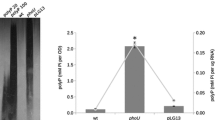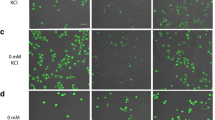Summary
The mode of expression was investigated for two positive regulatory genes PHO2 and PHO4, whose products are indispensable for the transcriptional control of the structural genes of repressible acid phosphatase and the inorganic phosphate (Pi) transport system in Saccharomyces cerevisiae. Northern analysis of poly(A)+ RNA of the wild-type and the pho regulatory mutants with PHO4 DNA as hybridization probe and expressional analysis of a pho4′-'lacZ fused gene on a YEp plasmid revealed that PHO4 is expressed at a low level, constitutively, and independently of the PHO regulatory system and Pi in the medium. Similar analyses with PHO2 DNA indicated that PHO2 is expressed at an even lower level than PHO4, and is repressed by Pi and by the active PHO2 product, possibly at the translational level, while retaining a substantial level of basal activity.
Similar content being viewed by others
References
Ammerer G, Hunter CP, Rothman JH, Saari GC, Valls LA, Stevens TH (1986) PEP4 gene of Saccharomyces cerevisiae encodes proteinase A, a vacuolar enzyme required for processing of vacuolar precursors. Mol Cell Biol 6:2490–2499
Arndt KT, Styles C, Fink GR (1987) Multiple global regulators control HIS4 transcription in yeast. Science 237:874–880
Bach ML, Lacroute F, Botstein D (1979) Evidence for transcriptional regulation of orotidine-5′-phosphate decarboxylase in yeast by hybridization of mRNA to the yeast structural gene cloned in Escherichia coli. Proc Natl Acad Sci USA 76:386–390
Bergman LW, McClinton DC, Madden SL, Preis LH (1986) Molecular analysis of the DNA sequences involved in the transcriptional regulation of the phosphate-repressible acid phosphatase gene (PHO5) of Saccharomyces cerevisiae Proc Natl Acad Sci USA 83:6070–6074
Bolivar F, Rodriguez RL, Betrach MC, Boyer HW (1977) Construction and characterization of new cloning vehicles. I. Ampicillin-resistant derivatives of the plasmid pMB9. Gene 2:75–93
Brazzell C, Ingolia TD (1984) Stimuli that induce a yeast heat shock gene fused to β-galactosidase. Mol Cell Biol 4:2573–2579
Bürglin TR (1988) The yeast regulatory gene PHO2 encodes a hemeo box. Cell 53:339–340
Casadaban MJ, Mortinez-Arias A, Shapira SK, Chou J (1983) β-Galactosidase gene fusions for analyzing gene expression in Escherichia coli and yeast. Methods Enzymol 100:293–308
Clarke L, Carbon J (1978) Functional expression of cloned yeast DNA in Escherichia coli: specific complementation of arginosuccinate lyase (argH) mutations. J Mol Biol 120:517–532
Finley D, Özkaynak E, Varshavsky A (1987) The yeast polyubiquitin gene is essential for resistance to high temperatures, starvation, and other stresses. Cell 48:1035–1046
Fouser LA, Friesen JD (1986) Mutations in a yeast intron demonstrate the importance of specific conserved nucleotides for the two stages of nuclear mRNA splicing. Cell 45:81–93
Gehring WJ (1987) Homeo boxes in the study of development. Science 236:1245–1252
Henicoff S, Cohen EH (1984) Sequences responsible for transcription termination on a gene segment in Saccharomyces cerevisiae. Mol Cell Biol 4:1515–1520
Ito H, Fukuda Y, Murata K, Kimura A (1983) Transformation of intact yeast cells treated with alkali cations. J Bacteriol 153:163–168
Jayaram M, Sutton A, Broach JR (1985) Properties of REP3 a cis-acting locus required for stable propagation of the Saccharomyces cerevisiae plasmid 2 μm circle. Mol Cell Biol 5:2466–2475
Kaneko Y, Toh-e A, Oshima Y (1982) Identification of the genetic locus for the structural gene and a new regulatory gene for the synthesis of repressible alkaline phosphatase in Saccharomyces cerevisiae. Mol Cell Biol 2:127–137
Kaneko Y, Tamai Y, Toh-e A, Oshima Y (1985) Transcriptional and post-transcriptional control of PHO8 expression by PHO regulatory genes in Saccharomyces cerevisiae Mol Cell Biol 5:248–252
Koren R, LeVitre J, Bostian KA (1986) Isolation of the positive-acting regulatory gene PHO4 from Saccharomyces cerevisiae. Gene 41:271–280
Kozak M (1984) Compilation and analysis of sequences upstream from the translational start site in eukaryotic mRNAs. Nucleic Acids Res 12:857–872
Kramer RA, Andersen N (1980) Isolation of yeast genes with mRNA levels controlled by phosphate concentration. Proc Natl Acad Sci USA 77:6541–6545
Legrain M, De Wilde M, Hilger F (1986) Isolation, physical characterization and expression analysis of the Saccharomyces cerevisiae positive regulatory gene PHO4. Nucleic Acids Res 14:3059–3073
Lemire JM, WillcocksT, Halvorson HO, Bostian KA (1985) Regulation of repressible acid phosphatase-gene transcription in Saccharomyces cerevisiae Mol Cell Biol 5:2131–2141
Messing J (1983) New M13 vectors for cloning. Methods Enzymol 101:20–78
Miller JH (1972) Experiments in molecular genetics. Cold Spring Harbor Laboratory Press, Cold Spring Harbor, New York
Morrison DA (1977) Transformation in Escherichia coli: cryogenic preservation of competent cells. J Bacteriol 132:349–351
Nakao J, Miyanohara A, Toh-e A, Matsubara K (1986) Saccharomyces cerevisiae PHO5 promoter region: location and function of the upstream activation site. Mol Cell Biol 6:2613–2623
Nishiwaki K, Hayashi N, Irie S, Chung DH, Harashima S, Oshima Y (1987) Structure of the yeast HIS5 gene responsive to general control of amino acid biosynthesis. Mol Gen Genet 208:159–167
Oshima Y (1982) Regulatory circuits for gene expression: the metabolism of galactose and of phosphate. In: Strathern JN, Jones EW, Broach JR (eds) The molecular biology of the yeast Saccharomyces: metabolism and gene expression. Cold Spring Harbor Laboratory Press, Cold Spring Harbor, New York, pp 159–180
Philippsen P, Thomas M, Kramer RA, Davis RW (1978) Unique arrangement of coding sequences for 5S, 5.8S, 18S and 25S ribosomal RNA in Saccharomyces cerevisiae as determined by R-loop and hybridization analysis. J Mol Biol 123:387–404
Rogers DT, Lemire JM, Bostian KA (1982) Acid phosphatase polypeptides in Saccharomyces cerevisiae are encoded by a differentially regulated multigene family. Proc Natl Acad Sci USA 79:2157–2161
Rose M, Casadaban MJ, Botstein D (1981) Yeast genes fused to β-galactosidase in Escherichia coli can be expressed normally in yeast. Proc Natl Acad Sci USA 78:2460–2464
Rudolph H, Hinnen A (1987) The yeast PHO5 promoter: phosphate-control elements and sequences mediating mRNA start-site selection. Proc Natl Acad Sci USA 84:1340–1344
Sengstag C, Hinnen A (1987) The sequence of the Saccharomyces cerevisiae gene PHO2 codes for a regulatory protein with unusual aminoacid composition. Nucleic Acids Res 15:233–246
Struhl K, Stinchomb DT, Scherer S, Davis RW (1979) High-frequency of transformation of yeast: autonomous replication of hybrid DNA molecules. Proc Natl Acad Sci USA 76:1035–1039
Tamai Y, Toh-e A, Oshima Y (1985) Regulation of inorganic phosphate transport systems in Saccharomyces cerevisiae. J Bacteriol 164:964–968
Toh-e A, Oshima Y (1974) Characterization of a dominant, constitutive mutation, PHOO, for the repressible acid phosphatase synthesis in Saccharomyces cerevisiae. J Bacteriol 120:608–617
Toh-e A, Shimauchi T (1986) Cloning and sequencing of the PHO80 gene and CEN15 of Saccharomyces cerevisiae. Yeast 2:129–139
Toh-e A, Ueda Y, Kakimoto S, Oshima Y (1973) Isolation and characterization of acid phosphatase mutants in Saccharomyces cerevisiae. J Bacteriol 113:727–738
Toh-e A, Nakamura H, Oshima Y (1976) A gene controlling the synthesis of non specific alkaline phosphatase in Saccharomyces cerevisiae. Biochim Biophys Acta 428:182–192
Wiemken A, Schellenberg M, Urech K (1979) Vacuoles: the sole compartments of digestive enzymes in yeast (Saccharomyces cerevisiae)? Arch Microbiol 123:23–35
Woolford CA, Daniels LB, Park FJ, Jones EW, van Arsdell JN, Innis MA (1986) The PEP4 gene encodes an aspartyl protease implicated in the posttranslational regulation of Saccharomyces cerevisiae vacuolar hydrolases. Mol Cell Biol 6:2500–2510
Yoshida K, Kuromitsu Z, Ogawa N, Ogawa K, Oshima Y (1987) Regulatory circuit for phosphatase synthesis in Saccharomyces cerevisiae. In: Torriani-Gorini A, Silver S, Yagil E, Rothman FG, Wright A (eds) Phosphate metabolism and cellular regulation in microorganisms. American Society for Microbiology, Washington DC, pp 49–55
Zubenko GS, Park FJ, Jones EW (1983) Mutations in PEP4 locus of Saccharomyces cerevisiae block final step in maturation of two vacuolar hydrolases. Proc Natl Acad Sci USA 80:510–514
Author information
Authors and Affiliations
Additional information
Communicated by G.R. Fink
Rights and permissions
About this article
Cite this article
Yoshida, K., Kuromitsu, Z., Ogawa, N. et al. Mode of expression of the positive regulatory genes PHO2 and PHO4 of the phosphatase regulon in Saccharomyces cerevisiae . Mol Gen Genet 217, 31–39 (1989). https://doi.org/10.1007/BF00330939
Received:
Issue Date:
DOI: https://doi.org/10.1007/BF00330939




